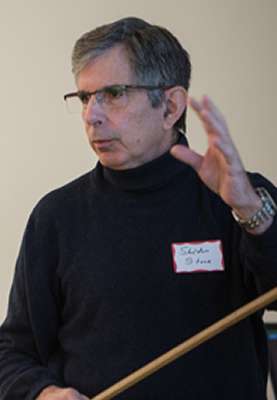Syracuse physicists aid in discovery of subatomic process

Physicists in Syracuse University's College of Arts and Sciences have helped discover a rare subatomic process.
Their findings, featured in the current issue of Nature magazine (Macmillan Publishers Ltd., 2015), stem from the study of proton collisions at the CERN Large Hadron Collider (LHC) in Geneva, Switzerland.
Distinguished Professor Sheldon Stone says the discovery came about when two LHC experiments recently combined their results and found overwhelming evidence of an extremely rare decay of a particle known as the Bs meson, which contains a bottom, or "b," quark and an anti-strange quark. (Quarks are the basic building blocks of protons and neutrons and come in six different types, or flavors, including bottom quarks and strange quarks.) Their findings not only provide an indirect way to test new models of new physics, but also shed light on the Standard Model, a theory describing the physical makeup of the Universe.
"This new result confirms that a Bs meson decays into two muons, a rare process that is predicted to occur only four times out of every one billion decays," says Stone, who splits time between CERN and the University. "That we were able to get the same results from two different experiments significantly increases our confidence in the data."
Lately, Stone has been working at CERN, which is home to four large multinational experiments, each with its own detector for collecting data from CERN's LHC particle accelerator.
The two experiments with results on this topic are Compact Muon Solenoid (CMS), which, along with the ATLAS experiment, made headlines in 2012 with its discovery of the Higgs Boson, and Large Hadron Collider beauty (LHCb), whose detector is pushing the boundaries of the study of baryogenesis (i.e., the imbalance of matter and antimatter in the Universe).
Stone says this imbalance is important because, without it, the early Universe would have evolved much differently. "There would have been as many anti-particles as particles, and they would have annihilated each other, leaving nothing behind but pure energy," he says.
For more than a decade, Stone has led a team of Syracuse researchers on the LHCb experiment. Their work mainly involves particle decay, where one particle disintegrates, or decays, into another particle after a lifespan of a picosecond (i.e., one trillionth of a second). ??
"The CMS and LHCb experiments have been studying these particles, in hopes of looking for cracks in the Standard Model," says Stone, adding that b quarks are of particular interest because they are the heaviest quarks to form stable particles. "Any deviations [from the model] would be evidence of new physics at play, such as new particles or forces influencing the known particles' behavior."
Stone adds that, while the initial Bs meson result "mostly matches" the Standard Model prediction, it deviates just enough to leave him and others wondering if such a discrepancy could be amplified by more data.
"It's not way off the Standard Model prediction, but it's low enough to keep us questioning," says Joel Butler, a physicist at Fermilab, also the site of CMS activity. "We've been taking more data this spring and hope to eventually nail down the value. When we have two to four times more data from the next run of the LHC, things will start to get really interesting."
Scientists have also found some evidence of decay of another B meson—this one with a bottom quark and an anti-down quark—but its disintegration is much rarer, estimated to occur once out of every 10 billion decays.
B mesons have been of interest to Stone and Butler since the late 1990s, when they studied quarks at the CLEO experiment at Cornell University and charm quarks at the FOCUS experiment at Fermilab.
"Fourteen billion years ago, the Universe began with a bang, and matter and anti-matter were formed," Stone says. "Just one second after the Big Bang, anti-matter all but disappeared. LHCb seeks to find out what really happened after the Big Bang that has allowed matter to survive and build the universe we inhabit today."
More information:
phys.org/news/2015-05-three-de … hysics-standard.html
Provided by Syracuse University